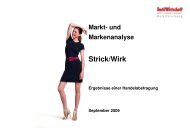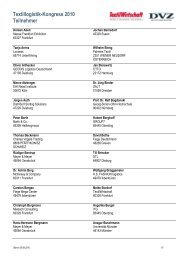UNIQLO Operations - TextilWirtschaft
UNIQLO Operations - TextilWirtschaft
UNIQLO Operations - TextilWirtschaft
Create successful ePaper yourself
Turn your PDF publications into a flip-book with our unique Google optimized e-Paper software.
Number of Stores and Total Sales<br />
Floor Space (<strong>UNIQLO</strong> Directly-<br />
Managed Stores in Japan)<br />
� Total Floor Space (m 2 )<br />
� Number of Stores<br />
321,397<br />
581<br />
358,181<br />
626<br />
392,020<br />
664<br />
427,412<br />
703<br />
471,314<br />
730<br />
FY ’03 ’04 ’05 ’06 ’07<br />
Year-on-Year Sales Trend<br />
at Existing Stores<br />
(<strong>UNIQLO</strong> Stores in Japan)<br />
FY ’03 ’04 ’05 ’06 ’07<br />
Year-on-Year Monthly Sales at Existing Stores in FY2007<br />
(<strong>UNIQLO</strong> Japan)<br />
� Sales<br />
(%)<br />
� Customer Numbers � Average Purchase per Customer<br />
12.6<br />
2.6 9.8<br />
9<br />
2006<br />
-3.4<br />
-4.5 -1.1<br />
5.7<br />
8.0<br />
2.2<br />
0.5<br />
-3.3<br />
-3.9<br />
8.1<br />
8.9<br />
0.7<br />
1.9<br />
10 11 12 1<br />
2007<br />
3.3<br />
1.4<br />
year, an expansion in the sales area per store along with the<br />
implementation of <strong>UNIQLO</strong>’s policy of opening of largeformat<br />
stores, and growth of 1.4% in sales of existing stores.<br />
During fiscal 2007, <strong>UNIQLO</strong> opened 75 stores and closed<br />
48, leaving a total of 730 directly-managed stores and 748<br />
stores (including franchise stores) at the end of the fiscal year.<br />
Of this total number of stores, large-format stores with 1,600<br />
square meters in sales space rose by 21. Also, as a result of<br />
<strong>UNIQLO</strong>’s scrap and build strategy, the average sales space<br />
per store rose to 653 square meters, representing an<br />
increase of 7.2% from the previous year.<br />
In the development of its store network, <strong>UNIQLO</strong> has<br />
taken initiatives since fiscal 2005 to open stores other than<br />
the standard suburban freestanding roadside stores. New<br />
stores have been situated in a greater variety of new locations<br />
and venues, such as urban centers, and have included<br />
large-format stores and specialized stores. With regard to<br />
location, during fiscal 2007, there was a rush to set up new,<br />
larger commercial outlets in the retail industry accompanying<br />
the revision of the three urban development laws governing<br />
store location and size, and <strong>UNIQLO</strong> responded to this development<br />
by aggressively opening new stores in shopping centers<br />
and urban commercial buildings with high levels of<br />
customer drawing power. Regarding roadside stores in urban<br />
areas, the new store located in Tokyo’s Setagaya Chitosedai<br />
residential area reported a robust sales performance for the<br />
fiscal year under review. With regard to store venue and size,<br />
<strong>UNIQLO</strong> moved forward with the development of new stores<br />
suited to individual shopping areas, while adhering strictly to<br />
(%)<br />
–19.7<br />
7.4<br />
4.5<br />
3.8<br />
6.9<br />
2.7<br />
2.9<br />
2.5<br />
2.9<br />
-4.9 -2.1<br />
0.6<br />
2.1<br />
-3.3<br />
-1.3<br />
-11.3<br />
0.7<br />
-0.4<br />
-11.7<br />
1.4<br />
3.6<br />
-4.8<br />
2 3 4 5 6 7 8<br />
-1.4<br />
in-house standards. Store development focused on largeformat<br />
stores with 1,600 square meters of sales space, standard<br />
stores with sales space ranging from 700 square meters<br />
to 800 square meters, and smaller stores with about 160<br />
square meters located inside railway stations and other hightraffic<br />
locations. In addition, in April 2007 <strong>UNIQLO</strong> refurbished<br />
its store in Tokyo’s fashionable Harajuku district and opened<br />
a new “UT STORE HARAJUKU” specializing in T-shirts.<br />
<strong>UNIQLO</strong> has positioned large-format stores as its growth<br />
driver, and, since opening the first of these in the<br />
Shinsaibashi area of Osaka in October 2004, had opened a<br />
total of 7 such outlets through the end of August 2006, and<br />
the number grew to 28 through August 2007. Before beginning<br />
to open large-format stores, <strong>UNIQLO</strong> had expanded by<br />
concentrating on standard store locations handling standard<br />
merchandise and providing standard services; however,<br />
along with the movement to open large-format stores,<br />
<strong>UNIQLO</strong> has been able to expand the in-store inventory of<br />
colors and sizes of best-selling items and expand sales<br />
space for women’s items, which are expected to be a highergrowth<br />
area.<br />
During fiscal 2007, sales of existing outlets rose 1.4% over<br />
the previous fiscal year. Although the number of customers<br />
decreased 0.2%, overall sales rose because of an increase in<br />
sales per customer of 1.5%. The number of customers in the<br />
second half of the fiscal year was down 3.5%, but this was<br />
because of unseasonable weather conditions from the latter<br />
half of May onward, which resulted in a lackluster performance<br />
during the summer season. The rise in sales per customer was<br />
due to expansion in sales of denim products, such as skinny<br />
jeans, which resulted in an increase in average product prices.<br />
The gross profit margin of the <strong>UNIQLO</strong> Japan operations<br />
decreased 1.1 percentage points, to 45.4%. The principal<br />
reason for this decline was an increase in discount sales of<br />
inventories owing to the unusually warm winter weather in the<br />
first half of the fiscal year. In the second half, we strengthened<br />
our numerical monitoring functions to adjust the<br />
balance among production, sales, and inventories and thus<br />
gained control over the gross profit margin.<br />
<strong>UNIQLO</strong> International <strong>Operations</strong><br />
During the fiscal year ended August 31, 2007, <strong>UNIQLO</strong><br />
International operations posted sales of ¥16.9 billion, almost<br />
twice the level for the previous fiscal year. With the opening of<br />
global flagship stores in the United Kingdom and the United<br />
States, expenses are continuing to run ahead of sales resulting<br />
in losses, but operations in mainland China, including<br />
Hong Kong, and Korea are posting smooth performances<br />
and reporting profits. As a result, <strong>UNIQLO</strong> International operations<br />
as a whole reported a loss of ¥1.1 billion for the fiscal<br />
year under review, smaller than the ¥1.4 billion loss for the<br />
previous fiscal year.<br />
In its overseas operations, <strong>UNIQLO</strong> is implementing a<br />
“flagship store strategy” aimed at strengthening the <strong>UNIQLO</strong><br />
brand. In November 2006, <strong>UNIQLO</strong> successfully opened a<br />
global flagship store in New York’s trendy Soho district with<br />
3,300 square meters of sales floor space. In addition,<br />
FAST RETAILING ANNUAL REPORT 2007 47













